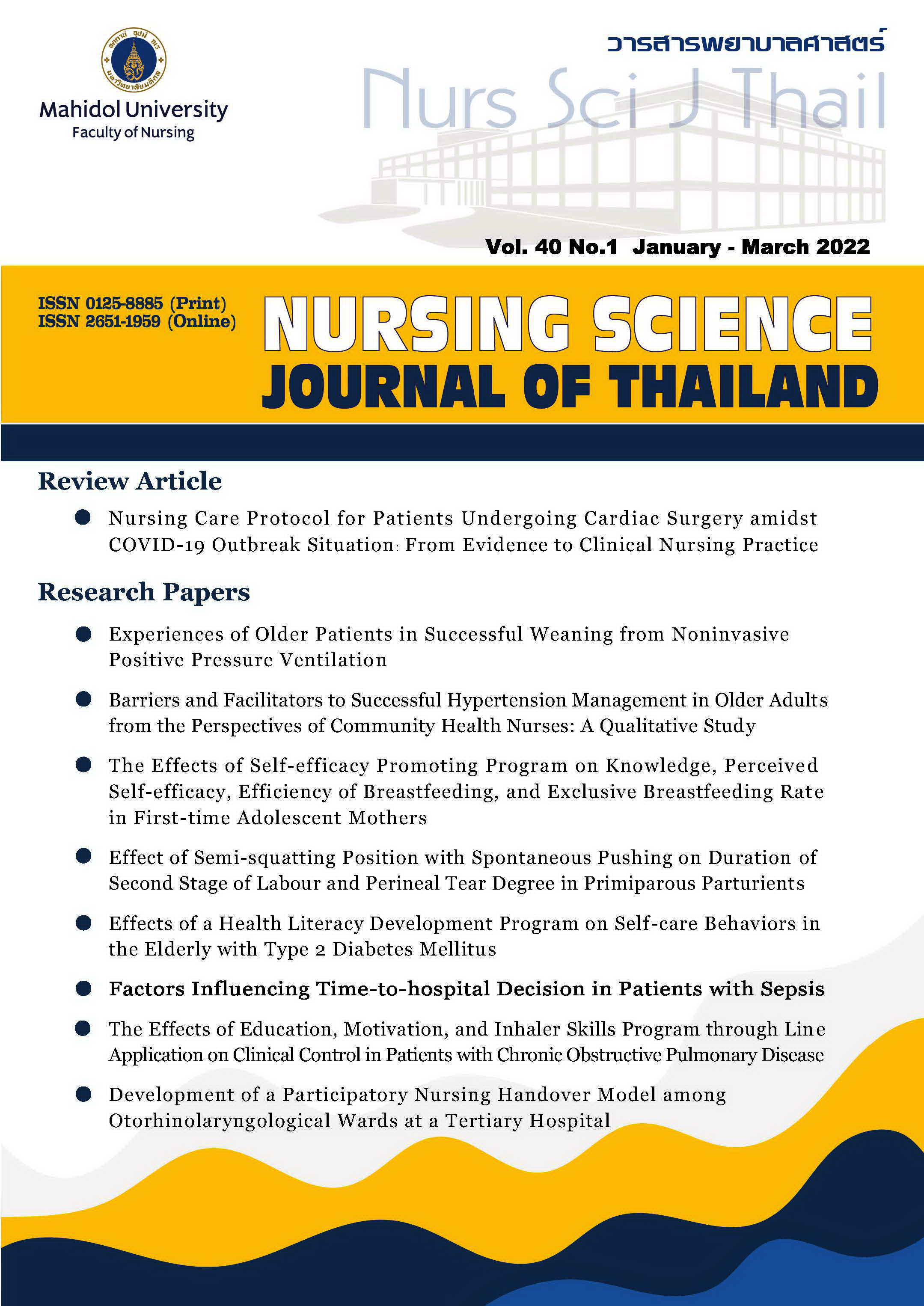อุปสรรคและสิ่งสนับสนุนความสำเร็จในการจัดการภาวะความดันโลหิตสูงในผู้สูงอายุ จากมุมมองของพยาบาลชุมชน : วิจัยเชิงคุณภาพ
Main Article Content
บทคัดย่อ
วัตถุประสงค์: เพื่อศึกษามุมมองของพยาบาลชุมชนเกี่ยวกับอุปสรรคและปัจจัยเอื้อต่อความสำเร็จในการจัดการภาวะความดันโลหิตสูงสำหรับผู้สูงอายุในชุมชนชนบท
รูปแบบการวิจัย: การวิจัยเชิงคุณภาพแบบพรรณนา
วิธีดำเนินการวิจัย: การสัมภาษณ์แบบกึ่งโครงสร้างกับพยาบาลชุมชนจำนวน 25 คน ที่รับผิดชอบเกี่ยวกับการจัดการภาวะความดันโลหิตสูงในผู้สูงอายุ ณ โรงพยาบาลส่งเสริมสุขภาพตำบลในชุมชนชนบท เก็บรวบรวมข้อมูลโดยมีการบันทึกเสียงและถอดเทปบันทึกเสียงทุกการสัมภาษณ์ วิเคราะห์ข้อมูลด้วยการวิเคราะห์เชิงเนื้อหา
ผลการวิจัย: พยาบาลชุมชนระบุอุปสรรคต่อความสำเร็จในการจัดการภาวะความดันโลหิตสูงสำหรับผู้สูงอายุ คือ 1) อุปสรรคจากพยาบาลชุมชน ได้แก่ ภาระงานมาก และขาดความรู้ในการให้คำปรึกษาเกี่ยวกับภาวะความดันโลหิตสูง และ 2) อุปสรรคจากผู้ป่วยและครอบครัว ได้แก่ การไม่ปรับเปลี่ยนวิถีการดำเนินชีวิต ความเชื่อในทางลบของผู้ป่วย และหลีกเลี่ยงการเป็นภาระแก่ครอบครัว สำหรับสิ่งสนับสนุน คือ 1) หุ้นส่วนแห่งความร่วมมือ ได้แก่ การสร้างความร่วมมือกับครอบครัวและอาสาสมัครสาธารณสุข และ 2) ข้อมูล ได้แก่ การให้ข้อมูลเกี่ยวกับภาวะสุขภาพปัจจุบัน
สรุปและข้อเสนอแนะ: การศึกษานี้ทำให้เกิดความเข้าใจมุมมองของพยาบาลชุมชนเกี่ยวกับอุปสรรคและสิ่งสนับสนุนการต่อการจัดการภาวะความดันโลหิตสูงในผู้สูงอายุในชนบท อย่างไรก็ตามความสำเร็จของการจัดการภาวะความดันโลหิตสูงจะเกิดขึ้นหรือไม่นั้นขึ้นอยู่กับการแก้ไขอุปสรรค เช่น ความเหมาะสมของภาระงาน และการส่งเสริมการปรับเปลี่ยนวิถีชีวิตของผู้ป่วย การวิจัยครั้งต่อไปควรศึกษาการจัดการตนเองของผู้สูงอายุเพื่อควบคุมความดันโลหิต
Article Details
ลิขสิทธิ์: วารสารพยาบาลศาสตร์เป็นเจ้าของลิขสิทธิ์ในการเผยแพร่ผลงานที่ตีพิมพ์ ห้ามผู้ใดนำบทความที่ได้รับการตีพิมพ์ในวารสารพยาบาลศาสตร์ไปเผยแพร่ในลักษณะต่างๆ ดังต่อไปนี้ การส่งบทความไปตีพิมพ์เผยแพร่ที่อื่น การนำบทความเผยแพร่ออนไลน์ การถ่ายเอกสารบทความเพื่อกิจกรรมที่ไม่ใช่การเรียนการสอน ยกเว้นเสียแต่ได้รับอนุญาตจากวารสารพยาบาลศาสตร์

Disclaimer: เนื้อหาบทความหรือข้อคิดเห็นใดๆ ในวารสารพยาบาลศาสตร์ ถือเป็นความรับผิดชอบของผู้เขียน กองบรรณาธิการไม่จำเป็นต้องเห็นด้วยและไม่มีส่วนรับผิดชอบแต่อย่างใด
เอกสารอ้างอิง
Thawornchaisit P, de Looze F, Reid CM, Seubsman S-A, Sleigh AC. Thai Cohort Study Team. Health-risk factors and the incidence of hypertension: 4-year prospective findings from a national cohort of 60569 Thai open university students. BMJ Open. 2013;3(6):e002826. doi: 10.1136/bmjopen-2013-002826.
Raji YR, Abiona T, Gureje O. Awareness of hypertension and its impact on blood pressure control among elderly Nigerians: report from the Ibadan study of aging. Pan Afr Med J. 2017;27:190. doi: 10.11604/pamj.2017.27.190.11682.
Aekplakorn W, Sangthong R, Kessomboon P, Putwatana P, Inthawong R, Taneepanichaskul S, et al. Changes in prevalence, awareness, treatment and control of hypertension in Thai population, 2004-2009; Thai National Health Examination Survey III-IV. J Hypertens. 2012;30(9):1734-42. doi: 10.1097/HJH.0b013e3283568158.
Leelacharas L, Kerdonfag P, Chontichachalalauk J, Sanongdej W. Illness perceptions, lifestyle behaviors, social support, and cardiovascular risks in people with hypertension in urban and rural areas of Thailand. Pac Rim Int J Nurs Res. 2015;19(3):245-56.
Roubsanthisuk W, Silaruks S, Ophascharoensuk V, Sirinak C, Phrommayon P. Hypertension in Thailand: a message from the Thai hypertension society on world hypertension day 2017. J Med Assoc Thai. 2018;101(5):705-6.
Woratanarat T, Woratanarat P, Lektip C. Primary health care systems (PRIMASYS): Case study from Thailand, abridged version [Internet]. Geneva: World Health Organization; 2017 [cited 2021 Mar 18]. Available from: https://www.researchgate.net/profile/Thira-Woratanarat/publication/321487332_PRIMARY_HEALTH_CARE_SYSTEMS_PRIMASYS/links/5a24abb34585155dd41eb419/PRIMARY-HEALTH-CARE-SYSTEMS-PRIMASYS.pdf.
Narasri P, Chaladthanyagid K, Piaseu N. Nurses’ role s in primary care management of non-communicable diseases toward sustainable development goals. Ramathibodi Nursing Journal. 2016;23(1):27-43. (in Thai).
Thai Hypertension Society. 2019 Thai guidelines on the treatment of hypertension. Chiang Mai: Trick Think; 2019. 78 p.
Ahn YH, Ham OK. Factors associated with medication adherence among medical-aid beneficiaries with hypertension. West J Nurs Res. 2016;38(10):1298-312. doi: 10.1177/0193945916651824.
Ma C. A cross-sectional survey of medication adherence and associated factors for rural patients with hypertension. Appl Nurs Res. 2016;31:94-9. doi: 10.1016/j.apnr.2016.01.004.
Rimando M. Perceived barriers to and facilitators of hypertension management among underserved African American older adults. Ethn Dis. 2015;25(3):329-36. doi: 10.18865/ed.25.3.329.
Khatib R, Schwalm J-D, Yusuf S, Haynes RB, McKee M, Khan M, et al. Patient and healthcare provider barriers to hypertension awareness, treatment and follow up: A systematic review and meta-analysis of qualitative and quantitative studies. PLoS One. 2014;9(1):e84238. doi: 10.1371/journal.pone.0084238.
Pezalla AE, Pettigrew J, Miller-Day M. Researching the researcher-as-instrument: an exercise in interviewer self-reflexivity. Qual Res. 2012;12(2):165-85. doi: 10.1177/1487941111422107.
Cho SJ, Kim J. Factors associated with nonadherence to antihypertensive medication. Nurs Health Sci. 2014;16(4):461-7. doi: 10.1111/nhs.12145.
Browne S, Macdonald S, May CR, Macleod U, Mair FS. Patient, carer and professional perspectives on barriers and facilitators to quality care in advanced heart failure. PLoS One. 2014;9(3):e93288. doi: 10.1371/journal.pone.0093288.
Raaijmakers LG, Hamers FJ, Martens MK, Bagchus C, de Vries NK, Kremers SP. Perceived facilitators and barriers in diabetes care: a qualitative study among health care professionals in the Netherlands. BMC Fam Pract. 2013;14:114. doi: 10.1186/1471-2296-14-114.
Hsieh H-F, Shannon SE. Three approaches to qualitative content analysis. Qual Health Res. 2005;15(9):1277–88. doi: 10.1177/1049732305276687.
Davy C, Bleasel J, Liu H, Tchan M, Ponniah S, Brown A. Effectiveness of chronic care models: opportunities for improving healthcare practice and health outcomes: a systematic review. BMC Health Serv Res. 2015;15:194. doi: 10.1186/s12913-015-0854-8.
Hussin EOD, Wong LP, Chong MC, Subramanian P. Nurses’ perceptions of barriers and facilitators and their association with the quality of end-of-life care. J Clin Nurs. 2018;27(3-4):e688-e702. doi: 10.1111/jocn.14130.
Vedanthan R, Tuikong N, Kofler C, Blank E, Kamano JH, Naanyu V, et al. Barriers and facilitators to nurse management of hypertension: a qualitative analysis from Western Kenya. Ethn Dis. 2016;26(3):315-22. doi: 10.18865/ed.26.3.315.
Gupta P, Patel P, Strauch B, Lai FY, Akbarov A, Maresova V, et al. Risk factors for nonadherence to antihypertensive treatment. Hypertension. 2017;69(6):1113-20. doi: 10.1161/HYPERTENSIONAHA.116.08729.
Newsom JT, Huguet N, McCarthy MJ, Ramage-Morin P, Kaplan MS, Bernier J, et al. Health behavior change following chronic illness in middle and later life. J Gerontol B Psychol Sci Soc Sci. 2012;67(3):279-88. doi: 10.1093/geronb/gbr103.
Zaider TI, Banerjee SC, Manna R, Coyle N, Pehrson C, Hammonds S, et al. Responding to challenging interactions with families: a training module for inpatient oncology nurses. Fam Syst Health. 2016;34(3):204-12. doi: 10.1037/fsh0000159.
Jack SM, Busser LD, Sheehan D, Gonzalez A, Zwygers EJ, MacMillan HL. Adaptation and implementation of the nurse-family partnership in Canada. Can J Public Health. 2012;103(7 Suppl 1):eS42-8. doi: 10.1007/BF03404459.
Tan J, Xu H, Fan Q, Neely O, Doma R, Gundi R, et al. Hypertension care coordination and feasibility of involving female community health volunteers in hypertension management in Kavre District, Nepal: a qualitative study. Glob Heart. 2020;15(1):73. doi: 10.5334/gh.872.
Robins LS, Jackson JE, Green BB, Korngiebel D, Force RW, Baldwin L-M. Barriers and facilitators to evidence-based blood pressure control in community practice. J Am Board Fam Med. 2013;26(5):539-57. doi: 10.3122/jabfm.2013.05.130060.


